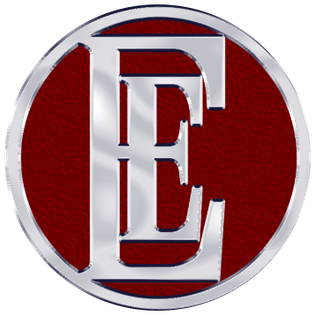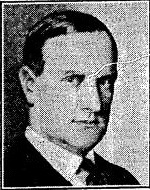Related Research Articles

George Westinghouse Jr. was an American entrepreneur and engineer based in Pennsylvania who created the railway air brake and was a pioneer of the electrical industry, receiving his first patent at the age of 19. Westinghouse saw the potential of using alternating current for electric power distribution in the early 1880s and put all his resources into developing and marketing it. This put Westinghouse's business in direct competition with Thomas Edison, who marketed direct current for electric power distribution. In 1911 Westinghouse received the American Institute of Electrical Engineers's (AIEE) Edison Medal "For meritorious achievement in connection with the development of the alternating current system." He founded the Westinghouse Electric Corporation in 1886.

An alternator is an electrical generator that converts mechanical energy to electrical energy in the form of alternating current. For reasons of cost and simplicity, most alternators use a rotating magnetic field with a stationary armature. Occasionally, a linear alternator or a rotating armature with a stationary magnetic field is used. In principle, any AC electrical generator can be called an alternator, but usually the term refers to small rotating machines driven by automotive and other internal combustion engines.

The English Electric Company Limited (EE) was a British industrial manufacturer formed after the armistice of World War I by amalgamating five businesses which, during the war, had been making munitions, armaments and aeroplanes.

Allgemeine Elektricitäts-Gesellschaft AG was a German producer of electrical equipment founded in Berlin as the Deutsche Edison-Gesellschaft für angewandte Elektricität in 1883 by Emil Rathenau. During the Second World War, AEG worked with the Nazi Party and benefited from forced labour from concentration camps. After World War II, its headquarters moved to Frankfurt am Main.

Bruce Peebles & Co. Ltd. was an Edinburgh industrial electrical engineering company.

The Ganz Works or Ganz was a group of companies operating between 1845 and 1949 in Budapest, Hungary. It was named after Ábrahám Ganz, the founder and the manager of the company. It is probably best known for the manufacture of tramcars, but was also a pioneer in the application of three-phase alternating current to electric railways. Ganz also made ships, bridge steel structures and high-voltage equipment. In the early 20th century the company experienced its heyday, it became the third largest industrial enterprise in Kingdom of Hungary after the Manfréd Weiss Steel and Metal Works and the MÁVAG company. Since 1989, various parts of Ganz have been taken over by other companies.

Sir Percy John Pybus, 1st Baronet, was a British Liberal Party politician.

Thornbury is an area of Bradford, in West Yorkshire, England on the border with the City of Leeds. Thornbury is located in the Bradford Moor ward and the Bradford East parliamentary constituency. Thornbury is contiguous with Pudsey – part of the City of Leeds conurbation and borders Laisterdyke, and Fagley in Eccleshill ward.
Metropolitan-Vickers, Metrovick, or Metrovicks, was a British heavy electrical engineering company of the early-to-mid 20th century formerly known as British Westinghouse. Highly diversified, it was particularly well known for its industrial electrical equipment such as generators, steam turbines, switchgear, transformers, electronics and railway traction equipment. Metrovick holds a place in history as the builders of the first commercial transistor computer, the Metrovick 950, and the first British axial-flow jet engine, the Metropolitan-Vickers F.2. Its factory in Trafford Park, Manchester, was for most of the 20th century one of the biggest and most important heavy engineering facilities in Britain and the world.

Edwin James Houston was an American electrical engineer, academic, businessman, inventor and writer.
Dick, Kerr and Company was a locomotive and tramcar manufacturer based in Kilmarnock, Scotland and Preston, England.

Coventry Ordnance Works was a British manufacturer of heavy guns particularly naval artillery jointly owned by Cammell Laird & Co of Sheffield and Birkenhead, Fairfield Shipbuilding and Engineering Company of Govan, Glasgow and John Brown & Company of Clydebank and Sheffield. Its core operations were from a 60-acre site in Stoney Stanton Road in the English city of Coventry, Warwickshire.

Brush Electrical Machines is a manufacturer of electrical generators typically for gas turbine and steam turbine driven applications. The main office is based at Loughborough in Leicestershire, UK.

Crompton Parkinson was a British electrical manufacturing company. It was formed in 1927 by the merger of Crompton & Co. with F & A. Parkinson Ltd. The brand is now part of Brook Crompton.

Rookes Evelyn Bell Crompton, CB, FRS was a British electrical engineer, industrialist and inventor. He was a pioneer of electric lighting and public electricity supply systems. The company he formed, Crompton & Co., was one of the world's first large-scale manufacturers of electrical equipment. He was also an early campaigner for an international standard for electrical systems. He was involved with both the practical and academic sides of his discipline, being a founder member of the International Electrotechnical Commission and twice president of the Institution of Electrical Engineers. He was a fellow of the Royal Society and a founder member of the Royal Automobile Club.

A magneto is an electrical generator that uses permanent magnets to produce periodic pulses of alternating current. Unlike a dynamo, a magneto does not contain a commutator to produce direct current. It is categorized as a form of alternator, although it is usually considered distinct from most other alternators, which use field coils rather than permanent magnets.
William Oke Manning was an English aeronautical engineer. Although none of his aircraft were built in large numbers he is remembered for his English Electric Wren ultralight and his flying-boats.

Johann Sigmund Schuckert was an electrical engineer and the founder of Schuckert & Co.. He was a pioneer of industrialization in Nuremberg and for the electrical industry a pioneer of international status.

Peter Brotherhood (1838–1902) was a British engineer. He invented the Brotherhood engine used for torpedoes as well as many other engineering products.
Arthur Lyon & Co Ltd. was a company based in London, England founded by Arthur Anderson Lyon M.I.Mech.E. (1876–1962).
References
- ↑ Page 10, Jane's World Railways, Jane's Yearbooks, 1956
- ↑ page 838, The Edinburgh Gazette, 22 August 1896, issue 10809
- ↑ Clerks, Assistants, Etc. wanted, Manchester Courier and Lancashire General Advertiser, page 2, Friday 13 December 1895
- ↑ U.S. consular reports, Special, Issues 61-71, 1913
- ↑ Headline: COMMERCIAL AND FINANCIAL ITEMS. :Yorkshire Evening Post, Thursday 5 February 1903
- ↑ PUBLIC COMPANIES, Sheffield Daily Telegraph, Monday 15 June 1903
- ↑ Albert Benedict Wolfe, Works Committees and Joint Industrial Councils: A Report United States Shipping Board Emergency Fleet Corporation, Industrial Relations Division, 1919
- ↑ Supplements to Commerce Reports: Review of Industrial and Trade Conditions in Foreign Countries, United States. Bureau of Foreign and Domestic Commerce, Government Print Office, 1920
- ↑ Dr. Robert Pohl. The Times, Monday, 19 March 1956; pg. 14; Issue 53483
- ↑ Sir John Pybus, native of Hull, The Yorkshire Post and Leeds Intelligencer, page 5, Thursday 24 October 1935